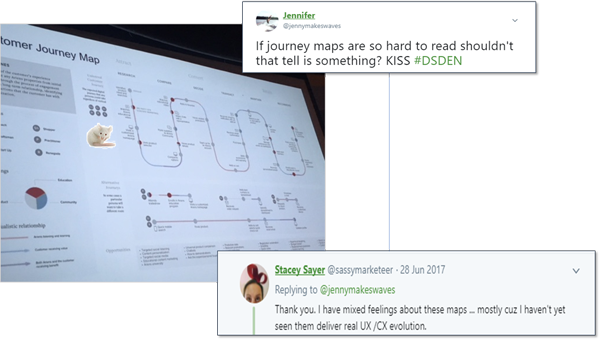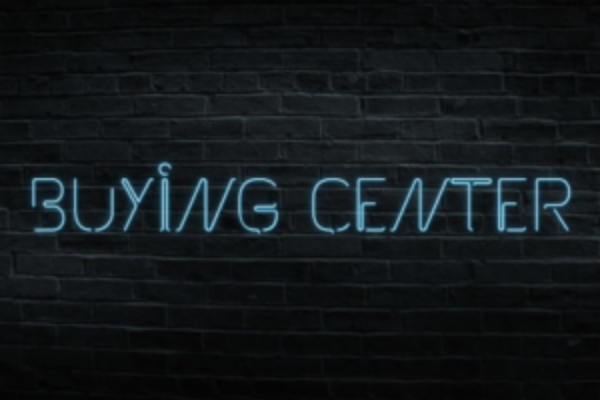This post has been republished on September 4, 2018.
In the few years since I wrote the Hitchhiker’s Guide to a Content Journey, the gap between B2B vendor content and buyer preference has widened significantly. Contributing to this content chasm is the evolved and diversified Buying Center. It can include several stakeholders with multiple roles, from up to five generations, varying levels of influence, degrees of expertise and oftentimes competing agendas. The C-Suite is putting enormous pressure on these groups to evaluate and recommend the right technologies and services as they prepare for Digital Transformation.
Vendors that deliver overly general content, lack deep industry insights and/or use too many empty buzzwords, do not help prospects with this giant set of tasks. Vendors that make it difficult for buyers to compare options, validate marketing claims, and provide other credible voices to help tell their story will lose them to those that will. Vendors that are too eager to pull prospects into their pipeline without carefully creating a connected omnichannel experience will fail. Vendors that provide relevant and credible content without strings attached early in a prospect’s exploration will succeed.
Based on the customer journeys we analyzed in 2017, the top 10 issues to plague B2B brands were . . .
10. Preventable quality issues (outdated content, broken links, too many links, internal search, even typos)
9. Industry jargon that rivals Vogon poetry
8. Excessive pop-ups and shameless gating
7. Too much brand voice, little or no third-party
6. Lack of clarity around what the product/service/solution is (messaging is not buyer-centric)
5. Too much content
4. Content that is too generic and doesn’t go deep enough on topics
3. Lack of regular and timely industry specific content
2. Little to no product reviews from customers
And, the number 1 issue is:
- Disconnected customer experiences (web, mobile, email, social, phone, in-person)
One of the challenges in marketing is that often we must come up with the ultimate answer without knowing what the ultimate question is. When the answer happens to be a customer journey map, you flash back to the last conference you attended when the mouse type appeared on the screen. You had dutifully tweeted a photo of it, but wondered how this giant one pager would help you create buyer centric content and deliver a great customer experience.

In reality, a great customer journey map is at least 42 pages long if not more, because a B2B purchase decision can span a couple of years and the internet is a firehose of content and information.
When the answer is a customer journey, there should be several questions asked at the outset:
- Who are our target buyers? What do we know about their pain points and their role in the decision journey? How do they prefer to consume their content?
- What are the various scenarios that would trigger a potential decision?
- What does the purchase decision look like from the buyer’s perspective?
- Where do they go for trusted and unbiased information?
DONT PANIC & GRAB YOUR TOWEL
Next, the insights and implications from the exercise above go into the journey planning and design process. Many journey maps take an inside-out approach and consider the user experience only from the perspective of owned channels. Much of the customer journey takes place off property on news sites, trade pubs, social media, customer reviews, analysts, in communities and blogs, at conferences, etc. When you include this type of holistic experience you get a more complete picture with a slew of actionable insights.
I am optimistic and predict in 2018 that successful brands who take a real journey-based approach will fill some gaps and provide (or drive to) content that is:
- Valuable for buyers in the consideration stage – such as customer reviews, competitive comparisons and analyst reports
- Needed for planning and the business case – such as ROI, how to budget in this brave new world, forecasting growth and how to drive change
- Clear, pragmatic and honest in terms of what they are selling, how much it costs and what implementation looks like and when
- Topically relevant to persona hot button issues and each stage of the journey
If you are just getting started, I would create or update your buyer personas as the first step. Below you’ll find an updated list of content resources since the first Hitchhiker’s Guide. Tweet me @Jennymakeswaves if you have a B2B prediction to add to the list, or if you have some good reading to share with the marketing community. Follow @ComBlu for the latest industry news and content.
Trying to be more buyer-centric? Here are some good resources.
- B2B Summer Reads
- Customer Experience – Lessons From The MOB
- Lead Gen Killed The Digital Star
- Customer Interrupted
- B2B Personas: 5 DIY Hacks to Help Drive Your Content Strategy Forward
- Topic Modeling: Pave the Way for Your B2B Content Roadmap
- Content Maturity Model

Senior Consultant
Jenny is a digital content strategist, who leads customer-centric engagements that focus on understanding B2B buying behaviors and developing custom roadmaps.
Her expertise is creating buyer personas and mapping digital content journeys to assess the multi-channel user experience. She helps clients operationalize plans across workstreams and identifies processes to create efficiencies in marketing operations. Jenny also has extensive time under her belt developing and managing customer advocacy programs and community building.
She has helped a diverse group of organizations including Cisco, VMware, Verizon, Microsoft, Dell, BMO Harris, Capital One and many others become more customer-centric.

